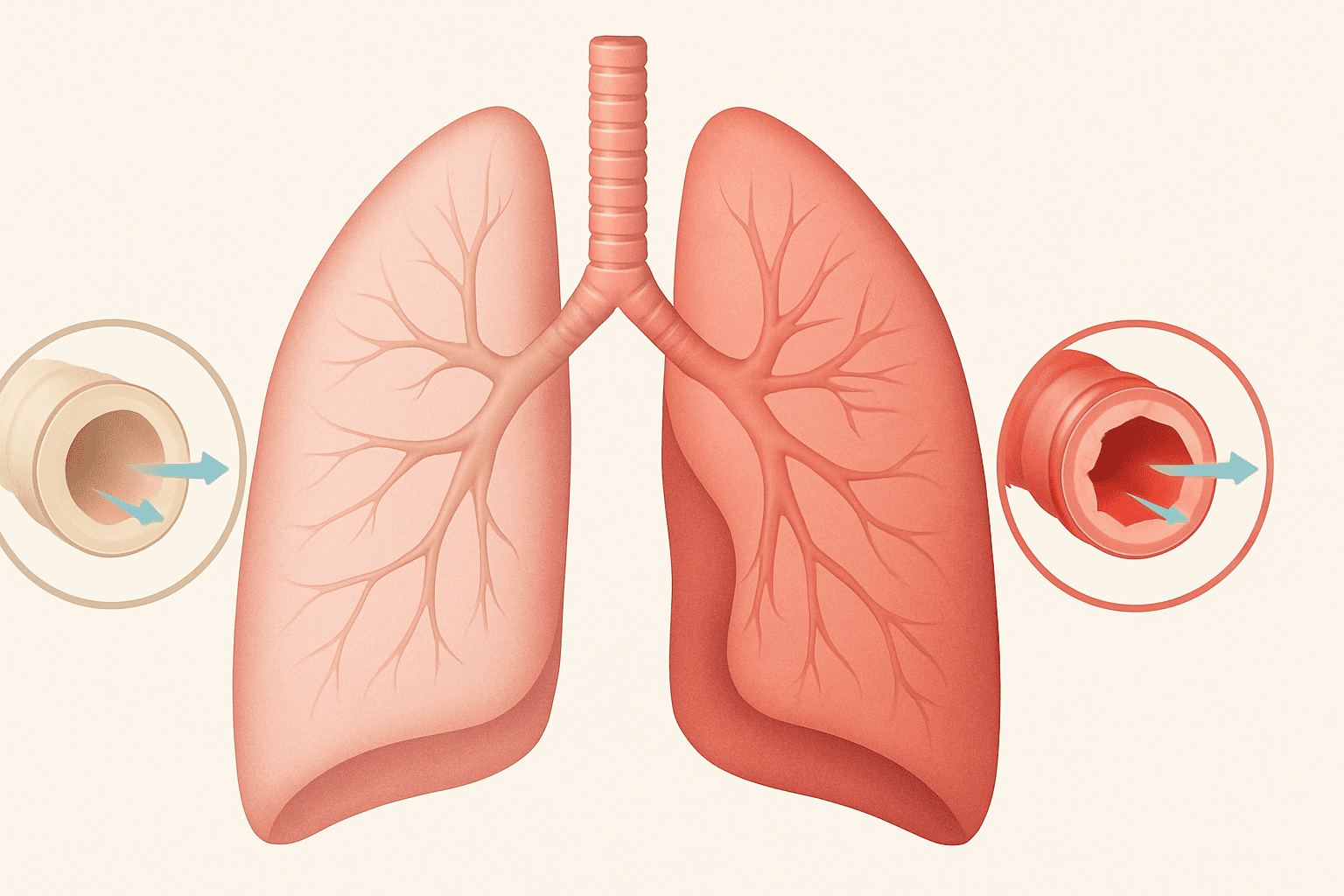Living with asthma doesn’t mean you have to accept limitations on your physical capabilities. While asthma is a chronic respiratory condition characterized by inflammation and narrowing of the airways, modern research and holistic techniques alike suggest that targeted breathing practices can significantly improve respiratory efficiency, particularly in individuals seeking to enhance endurance and overall performance. By mastering specific breathing exercises for asthma and understanding how to strengthen lungs with asthma through consistent practice, people with asthma can achieve improved stamina, resilience, and lung capacity. This article explores how such techniques can serve as both therapeutic tools and performance-enhancing strategies for asthmatics.
You may also like: How to Increase Stamina and Endurance Naturally: Smart Training Tips and Nutrition Habits That Support Cardiovascular Fitness

Understanding the Respiratory Challenges of Asthma
Asthma is fundamentally a disorder of airway hyperreactivity, which means the bronchi in the lungs are more sensitive and prone to constriction, particularly in response to triggers such as allergens, cold air, or intense physical exertion. During an asthma attack, this narrowing severely restricts airflow, leading to symptoms such as wheezing, coughing, shortness of breath, and chest tightness. This presents a unique challenge for individuals pursuing endurance training or performance-based activities, where oxygen demand rises sharply and sustained lung function becomes critical.
One of the key issues lies in the reduced ability of asthmatic lungs to efficiently ventilate during stress. This inefficiency can reduce oxygen delivery to the muscles, which can in turn limit stamina. However, while asthma poses certain challenges, it does not equate to a complete restriction on physical activity. In fact, strategic training that includes breathing exercises for asthmatics can help optimize pulmonary function and promote a more resilient respiratory system over time.
The Science Behind Breathing Exercises for Asthma
Scientific inquiry has long supported the idea that regular respiratory training can yield measurable improvements in lung function and asthma management. Certain breathing techniques for asthma aim to normalize breathing patterns, reduce airway hyperreactivity, and enhance diaphragmatic strength. These methods are rooted in principles of controlled inhalation and exhalation, often incorporating mindfulness and body awareness to retrain how individuals breathe both at rest and during activity.
One widely studied technique is the Buteyko method, which involves shallow nasal breathing designed to reduce hyperventilation and encourage carbon dioxide tolerance. Another notable approach is the Papworth method, which emphasizes relaxed diaphragmatic breathing and helps reduce over-reliance on the accessory muscles of respiration. Both have been shown in clinical studies to improve quality of life in asthma patients and reduce reliance on rescue inhalers. Breathing exercises for asthma are not just theoretical—they have tangible, evidence-backed effects when practiced consistently.

How to Strengthen Lungs with Asthma Through Practice
Strengthening the lungs when living with asthma is not about building muscle in the traditional sense but about optimizing respiratory efficiency and endurance. Just as athletes condition their cardiovascular system through repeated exposure to aerobic stress, asthmatics can benefit from progressively challenging their respiratory system under safe and controlled conditions. This involves incorporating regular breathing exercises for asthmatics that gradually build tolerance to physical activity and promote healthier breathing patterns.
A simple yet effective strategy is integrating breath-hold techniques into a daily routine. Holding the breath after exhalation—under medical guidance—can improve carbon dioxide tolerance, a key factor in reducing the sensation of breathlessness. Additionally, breathing exercises for wheezing and other asthma symptoms can train individuals to stay calm during flare-ups, preventing panic and promoting better control of airflow.
Consistency is crucial. Just as strength training for the body requires time and repetition, the same principle applies when learning how to strengthen lungs with asthma. Daily or near-daily practice of specific breathing methods for asthma can yield measurable improvements in lung capacity and stamina, often within weeks.
Building Endurance with Breathing Techniques for Asthma
Endurance athletes, whether asthmatic or not, understand that respiratory conditioning is integral to optimal performance. For those managing asthma, the ability to increase stamina hinges on both pharmacological support and behavioral interventions such as breathing technique asthma training. Proper breathing during physical exertion can help maintain airflow and prevent airway constriction, reducing the risk of exercise-induced bronchospasm.
One effective approach involves rhythmic breathing, where breath patterns are synchronized with movement—for example, inhaling for three steps and exhaling for two while running. This helps establish a consistent flow of oxygen and minimizes erratic breathing patterns that can exacerbate asthma symptoms. Breathing for asthmatics should also include warm-up and cool-down phases that feature slower, deeper breathing to prime the lungs and ease the transition into and out of activity.
Cardiovascular exercises like swimming, cycling, and walking are also ideal for building endurance without overtaxing the lungs. When combined with targeted breathing tips for asthma, these activities can support both respiratory health and physical performance, reinforcing the idea that asthma does not preclude athletic or active lifestyles.

Using Breathing Methods for Asthma to Enhance Athletic Performance
Athletic performance is a product of numerous physiological factors, including cardiovascular output, muscular strength, and neuromuscular coordination. However, respiratory efficiency remains a foundational element, particularly for endurance sports. For asthmatics, mastering breathing methods for asthma can make a significant difference in both training outcomes and competitive results.
Techniques such as box breathing (inhaling, holding, exhaling, and holding again in equal parts) can promote mental calmness and respiratory rhythm, both of which are essential during intense exertion. Similarly, alternate nostril breathing, commonly used in yoga traditions, has been linked to improvements in parasympathetic tone, helping the body recover more efficiently after strenuous activity. These techniques align with modern understandings of how to increase lung capacity for asthmatics while simultaneously enhancing focus and reducing performance anxiety.
It’s also important for athletes to be proactive about tracking their respiratory metrics. Using peak flow meters or spirometry tools can help asthmatics understand their baseline lung function and identify trends over time. Incorporating data-driven feedback into a training regimen ensures that breathing for asthma becomes an intentional, measurable part of athletic development.

Managing Flare-Ups with Asthma Attack Breathing Exercises
Despite best efforts, flare-ups are still a possibility for individuals with asthma, particularly during allergy seasons or in polluted environments. In such cases, asthma attack breathing exercises can serve as critical tools for regaining control. These exercises focus on slowing the breath, promoting relaxation, and maximizing the efficiency of each inhalation and exhalation during distressing moments.
Pursed-lip breathing, for example, involves inhaling slowly through the nose and exhaling gently through pursed lips, as if blowing out a candle. This method helps maintain positive airway pressure, preventing airway collapse and making it easier to expel trapped air. Diaphragmatic breathing, or belly breathing, also proves effective by reducing the reliance on upper chest muscles and encouraging fuller breaths that use the entire lung volume.
Educating individuals on these techniques before a crisis occurs is essential. Practicing them regularly ensures they become second nature when needed most. For caregivers and trainers, teaching these methods empowers individuals to navigate episodes of acute bronchoconstriction with greater confidence and less reliance on emergency interventions.

The Role of Lifestyle in Supporting Lung Strength and Function
While breathing exercises for asthma are powerful tools, they are most effective when combined with a comprehensive lifestyle approach. Nutrition, hydration, sleep quality, and environmental management all influence lung health and should not be overlooked in any strategy aimed at increasing endurance and lung capacity for asthmatics.
Anti-inflammatory diets rich in omega-3 fatty acids, antioxidants, and flavonoids may help reduce systemic inflammation, including within the airways. Maintaining adequate hydration supports the thin layer of mucus that lines the airways, aiding in the clearance of irritants. Good sleep hygiene ensures the body is well-rested and capable of managing daily respiratory demands, while air quality control—through filters or avoiding known triggers—can prevent unnecessary exposure to irritants.
In combination, these factors contribute to a more resilient respiratory system. They create the foundation upon which targeted breathing practices can thrive, allowing individuals to truly benefit from their efforts in how to strengthen lungs with asthma and increase physical performance.
Customizing Breathing Tips for Asthma by Individual Needs
Asthma is a heterogeneous condition, meaning its presentation and severity vary widely among individuals. What works for one person may not be effective for another, which makes personalization essential in any breathing regimen. Some may respond well to dynamic exercises like power breathing, while others might benefit more from restorative practices that emphasize slow, meditative breath control.
Customizing breathing tips for asthma requires a thoughtful evaluation of an individual’s triggers, lifestyle, activity level, and baseline lung function. Consulting with healthcare professionals—including pulmonologists, respiratory therapists, and certified athletic trainers—can provide clarity and direction. They can guide individuals in choosing the most appropriate breathing exercises for wheezing, endurance training, or anxiety management related to asthma.
Wearable technology and digital health platforms have also advanced the ability to personalize respiratory training. Apps that provide guided breathing sessions, monitor breath rate, and offer biofeedback can make it easier to integrate effective practices into daily life. With proper customization, breathing for asthmatics becomes not just a coping mechanism, but a performance-enhancing lifestyle tool.

The Psychological Benefits of Controlled Breathing for Asthmatics
Beyond the physiological benefits, controlled breathing offers profound psychological advantages for individuals managing asthma. Anxiety and panic are common during asthma episodes, and these emotional responses can intensify symptoms. Learning and regularly practicing controlled breathing exercises for asthmatics can mitigate these effects by fostering a greater sense of internal control and resilience.
Mindfulness-based interventions, which often include breathing components, have been shown to reduce perceived stress and improve asthma-related quality of life. The simple act of tuning into the breath helps ground individuals in the present moment, making it easier to respond calmly to symptoms or triggers. In performance settings, this same psychological resilience can help athletes with asthma remain focused and composed under pressure.
When breathing methods for asthma are practiced with intention, they can serve as both a physical and emotional anchor. This dual benefit makes them especially valuable in long-term asthma management and in cultivating the mindset needed for endurance-based goals.
Frequently Asked Questions (FAQ): Breathing Exercises and Lung Strengthening for Asthma
1. Can breathing exercises for asthma actually change long-term lung function?
Yes, when practiced consistently and correctly, breathing exercises for asthma can have a meaningful long-term impact on lung function. These exercises don’t alter the anatomical structure of the lungs but can dramatically improve functional efficiency by strengthening respiratory muscles and optimizing oxygen exchange. Over time, this training can reduce breathlessness during everyday activities and increase tolerance for physical exertion. Individuals who incorporate structured breathing for asthma into their daily routine often report fewer symptoms and a decreased need for quick-relief inhalers. These improvements tend to accumulate gradually, especially when breathing exercises for asthmatics are paired with medical supervision and lifestyle changes.
2. What makes a breathing technique for asthma more effective than simply breathing deeply?
A well-developed breathing technique for asthma goes beyond just taking deep breaths; it involves deliberate control of breath pace, volume, and rhythm to stabilize the airways. Deep breathing alone may lead to hyperventilation if not guided properly, whereas proven techniques like nasal breathing, paced exhalation, or breath-holding after exhale are designed to improve CO2 tolerance and reduce airway sensitivity. This kind of structured training helps train the body to function with less oxygen, which is particularly useful for people prone to exercise-induced bronchospasm. More advanced breathing methods for asthma also work on reducing unnecessary tension in the neck and chest, which further aids in improving breathing efficiency. Ultimately, the technique must be tailored to the individual’s asthma triggers and symptom patterns.
3. Are there specialized breathing exercises for wheezing that differ from general techniques?
Yes, breathing exercises for wheezing are typically designed to restore airflow when the airways are partially obstructed. Unlike general breathing for asthmatics that focuses on long-term resilience, these acute-phase exercises emphasize gentle airflow and prolonged exhalation. Pursed-lip breathing is a common example, where the slow release of air through pursed lips keeps the airways open longer and makes it easier to expel trapped air. Another useful technique is “reverse breathing,” where the exhale is emphasized more than the inhale, which helps reduce the sensation of tightness. Such practices are particularly helpful during episodes of wheezing and can complement asthma attack breathing exercises to bring faster symptom relief.
4. How can athletes with asthma safely incorporate breathing methods for asthma into high-performance training?
Athletes with asthma can benefit greatly from integrating targeted breathing methods for asthma into their training routines. These methods should be introduced gradually during lower-intensity workouts to monitor their effect on lung function and perceived exertion. For example, rhythmic breathing coordinated with movement—like breathing every three pedal strokes during cycling—helps create consistency and improves stamina. When combined with proper warm-up routines and cooldown phases, this can prevent bronchospasm and enhance recovery. As athletes increase the intensity of their training, these breathing techniques should evolve into customized regimens that support their specific sport and competition demands, especially when focusing on how to increase lung capacity for asthmatics.
5. What role do psychological techniques play in mastering asthma attack breathing exercises?
Psychological readiness is often underestimated in managing asthma attacks. Incorporating mindfulness and relaxation practices into asthma attack breathing exercises enhances their effectiveness by calming the nervous system and reducing panic-driven hyperventilation. Techniques such as guided imagery, body scanning, or mindfulness-based stress reduction (MBSR) can be paired with breathing for asthma to create a more holistic response to stress-induced flare-ups. For example, if someone begins wheezing during a stressful situation, integrating a breathing exercise for wheezing with a visual cue or calming phrase can help reduce symptoms more rapidly. This blend of psychological resilience and respiratory control is especially useful in high-pressure environments like competitive sports or public speaking.
6. How do you know if you’re doing breathing exercises for asthmatics correctly?
Proper technique matters as much as consistency. One of the best ways to determine if your breathing exercises for asthmatics are effective is by tracking outcomes over time—this includes reduced frequency of symptoms, easier recovery after exertion, and better control during known trigger exposures. Subjectively, you should notice smoother, quieter breathing and less upper chest movement, which indicates better diaphragmatic engagement. If you’re unsure, working with a respiratory therapist or certified trainer familiar with breathing tips for asthma can provide personalized feedback and adjustments. Wearable health technology, such as respiratory rate monitors, can also offer real-time insight into your progress, especially as you work on how to strengthen lungs with asthma.
7. Are there specific tools or devices that can support breathing for asthmatics?
Yes, several tools are available to enhance breathing for asthmatics and ensure proper technique. Inspiratory muscle trainers (IMTs) can be used to strengthen the muscles involved in inhalation, making it easier to draw in air during exertion. Spirometers and peak flow meters can monitor lung capacity and variability in performance, which is crucial when assessing how to strengthen lungs for asthmatics systematically. Apps that guide users through breathing sequences and offer biofeedback can also be valuable, especially for those seeking structure in their daily training. These tools can provide both accountability and reassurance that the exercises are being done correctly and effectively.
8. Can children benefit from breathing exercises for asthma, or are these practices best suited for adults?
Children with asthma can absolutely benefit from tailored breathing exercises for asthma, though the approach should be age-appropriate and engaging. Games that involve blowing bubbles, controlled humming, or singing can be modified to act as effective breathing exercises for wheezing and general lung support. Incorporating these exercises into play makes them less intimidating and more enjoyable, fostering long-term respiratory health. It’s especially important to involve caregivers and educators in teaching breathing techniques so that they become a natural part of a child’s routine. Pediatric versions of breathing methods for asthma have shown promise in reducing symptoms and medication dependency when consistently practiced.
9. How can people with severe asthma adapt breathing tips for asthma to avoid triggering attacks?
Individuals with more severe asthma need to modify breathing tips for asthma to suit their sensitivity levels. This might involve shortening the duration of breath holds or limiting breath control exercises to seated or reclining positions until confidence and capacity improve. Nasal breathing may be emphasized to reduce cold air and particulate intake, especially in outdoor settings. People in this group may also benefit from pairing breathing exercises with gentle movement, such as yoga or tai chi, to avoid sudden respiratory stress. Above all, collaboration with healthcare providers is key when adjusting how to strengthen lungs with asthma in a safe and controlled way.
10. Is it possible to reverse decreased lung capacity, and how long does it take to see progress?
While structural changes in lung tissue cannot be reversed, functional improvements are absolutely possible. With consistent breathing technique asthma training, users often report noticeable gains in endurance, breath control, and symptom reduction within a few weeks. Progress may be faster when breathing for asthma is part of a comprehensive care plan that includes medication, nutrition, and physical activity. Monitoring improvements through peak flow readings or symptom diaries can reinforce motivation and fine-tune routines. The path to learning how to increase lung capacity for asthmatics is rarely linear, but with dedication, it often yields significant gains in quality of life and physical performance.
Conclusion: Breathing Exercises for Asthma as a Pathway to Resilience, Endurance, and Enhanced Performance
Living with asthma does not mean resigning oneself to diminished physical potential. With the right tools, techniques, and mindset, individuals can harness the power of breathing to transform their lung function and overall well-being. Breathing exercises for asthma, when practiced consistently and mindfully, offer more than symptom relief—they provide a strategic pathway to greater stamina, emotional balance, and athletic performance.
Through evidence-based methods, such as diaphragmatic breathing, breath holds, rhythmic techniques, and asthma attack breathing exercises, those with asthma can improve lung strength and endurance. These practices, when coupled with holistic lifestyle choices and professional guidance, create a resilient foundation for both daily wellness and peak performance. As we deepen our understanding of how to strengthen lungs with asthma, it becomes clear that breath—our most fundamental biological function—holds the key to unlocking untapped physical and psychological potential for asthmatics around the world.
Was this article helpful? Don’t let it stop with you. Share it right now with someone who needs to see it—whether it’s a friend, a colleague, or your whole network. And if staying ahead on this topic matters to you, subscribe to this publication for the most up-to-date information. You’ll get the latest insights delivered straight to you—no searching, no missing out.

